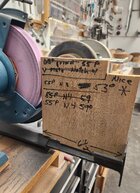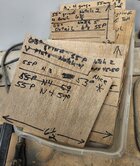I got a good deal on a used slow speed grinder with the basic Oneway wolverine setup and two aluminum oxide wheels. The grind angle for my current jig is set by adjusting the distance between the tip of the gouge and the jig. I made depth gauges for different grind angles and it is fast and repeatable. Seems that the varigrind uses a fixed distance between the jig and the tip of the tool and the grind angle is set by adjusting extension of the v-arm. What are the options for quickly and repeatably setting the v-arm to different extension distances corresponding to the grind angles I use (assume it will be used with a CBN wheel that will not be reduced in diameter with use)?
I'm late to this party. I cheat with the varigrind setup. I buy a separate jig for my common grinds and set each once. I know, that's a bit extreme but I'm more than a bit lazy...
To sent the length, I take an existing ground, paint the ground bevel with a blue Sharpie, mount it in the jig for that grind, then slide the v-arm back and forth until rotating the 600-grit CBN wheel a TINY bit by hand removes the blue color all the way from the heal to the tip. Lock it down and sharpen. I've been sharpening this way for lots of years. (Note, I use the jigs for bowl gouges - I sharpen all my spindle gouges on a Tormek with a 10" 1200 grit CBN wheel.
Also, I use the platforms with grinding skews, NRS, and some other tools. (I almost always use the mini platforms) To set the angle of the platform for different uses I made a set of setting gauges from plexiglas, now spray-painted white on the back for visibility. I simply hold the flat of the plastic against the platform and adjust the v-arm distance and platform angle, then grind. Works for me.
Some angle-setting gauges (before adding the white paint)
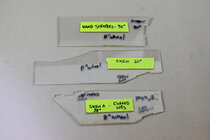
Setting up the platform to grind hand scrapers at 90-deg:
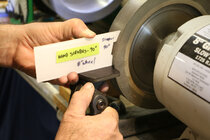
Some wheels also have abrasive on the edges. What sort of sharpening is done with the edges of the wheel? What are the advantages/disadvantage of rounded transition (radius edge) versus square?
I buy all my CBN wheels with square corners and 1" of grit down the flat sides. I find the flats useful for many things (making certain tools, cleaning up flats on mangled screwdrivers, modifying allen wrenches, etc.)
Here's just one example. I made this tool specifically to cut a recess for the chuck on a flat blank squeezed between the open jaws of a chuck on one side and a live center in the tail stock. The live center got in the way of most tools, so I ground this from an old tool. The square corner with side grit on coarse and fine CBN wheels let me easily shape the tool then sharpen it, with good relief to turn the recess with a slight dovetail if desired while staying clear of the live center. It would have been more challenging to make the tool another way, would prob have to change the design.
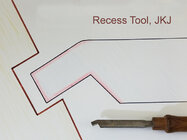
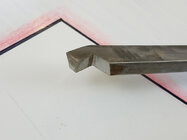
BTW, I keep a box of old tools with handles, either bought cheap or given to me. I make a variety of special tools from them. Also good to send a student home with a sharp tool they don't have. Be aware of one thing about old tools. Some are only hardened for the first few inches! (Cheapskate mfgrs!) I test each one for hardness with a small triangular file and mark the useful part of those that got cheated.
Also, the only advantage I know of for the rounded edges is to sharpen hollowing scraper-type bits that are permanently bonded to long boring bars. For a straight one, you can use the radius on one side of the wheel to sharpen 1/2 of the bit, then switch to the other side of the wheel to sharpen the other side. With the radius, you'd have to swing the entire tool like you do a gouge, perhaps difficult with a long bar! I don't use such tools (mine have removable bits sharpened with the little Jordan jig.)
JKJ











